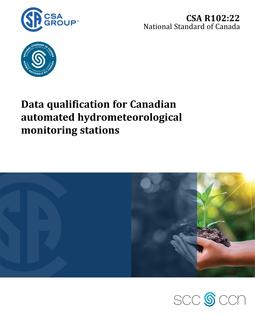Preface
This is the first edition of CSA R102, Data qualification for Canadian automated hydrometeorological monitoring stations. CSA Group has been commissioned to develop four national standards focusing on data collected by hydrometeorological monitoring stations and descriptive data about the stations. The standards are for a) the collection and public dissemination of metadata for hydrometeorological monitoring stations; b) the siting, operations, and maintenance of automated hydrometeorological monitoring stations; c) a data quality rating system; and d) the exchange of hydrometeorological data sets across information systems. These standards will promote the standardization of methods, procedures, techniques, and practices used for collecting hydrometeorological data and related information across Canada. Standardization and improved best practices will help make more hydrometeorological observations become more easily accessible to a larger and better-informed audience. The availability of standardized sets of metadata, and through a single portal, also helps gain access to information required for homogenizing data, improving asset management, and optimizing monitoring networks. This Standard was prepared by the Subcommittee on Data qualification for Canadian Automated Hydrometeorological Monitoring Stations under the jurisdiction of the Technical Committee on Weather Stations and the Strategic Steering Committee on Environment and Business Excellence, and has been formally approved by the Technical Committee. This Standard has been developed in compliance with Standards Council of Canada requirements for National Standards of Canada and was published as a National Standard of Canada by the CSA Group.
Scope
1.1 This Standard provides a framework to assess, tabulate, and quantify factors contributing to the quality of hydrometeorological data. It includes a description of the data quality rating system, a description of organization-wide factors linked to management systems, training and certification of operators, as well as data storage and archiving policies, and a description of instrument-specific factors.
1.2 This Standard does not include surface water, groundwater, detailed snow, glacier mass balance, and air quality monitoring equipment. Furthermore, this Standard excludes less commonly used instrumentation, such as acoustic Doppler radars, mini-weather radars, SODAR wind profilers, and ceilometers, as well as manually operated instrumentation.
1.3 In this Standard, “shall” is used to express a requirement, i.e., a provision that the user is obliged to satisfy in order to comply with the Standard; “should” is used to express a recommendation or that which is advised but not required; and “may” is used to express an option or that which is permissible within the limits of the Standard. Notes accompanying clauses do not include requirements or alternative requirements; the purpose of a note accompanying a clause is to separate from the text explanatory or informative material. Notes to tables and figures are considered part of the table or figure and may be written as requirements. Annexes are designated normative (mandatory) or informative (non-mandatory) to define their application.
Product Details
- Edition:
- 1st
- Published:
- 07/15/2022
- ISBN(s):
- 9781488341885
- Number of Pages:
- 54
- File Size:
- 1 file , 860 KB
- Product Code(s):
- 2429905, 2429906, 2429906, 2429905
- Note:
- This product is unavailable in Russia, Ukraine, Belarus
